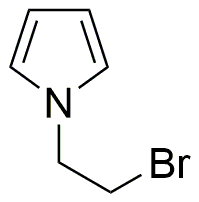1-(2-Bromoethyl)pyrrole is widely utilized in research focused on:
- Synthesis of Pharmaceuticals: This compound serves as an important intermediate in the synthesis of various pharmaceuticals, particularly in the development of anti-cancer agents and neuroprotective drugs.
- Material Science: It is used in the production of advanced materials, including polymers and coatings, enhancing properties like durability and resistance to environmental factors.
- Organic Electronics: The compound plays a role in the fabrication of organic electronic devices, such as organic light-emitting diodes (OLEDs), due to its favorable electronic properties.
- Research in Agrochemicals: It is explored for its potential applications in agrochemicals, particularly as a building block for developing new pesticides and herbicides.
- Biochemical Studies: Researchers utilize this compound in biochemical studies to investigate its interactions with biological systems, which can lead to insights in drug design and development.
General Information
Properties
Safety and Regulations
Applications
1-(2-Bromoethyl)pyrrole is widely utilized in research focused on:
- Synthesis of Pharmaceuticals: This compound serves as an important intermediate in the synthesis of various pharmaceuticals, particularly in the development of anti-cancer agents and neuroprotective drugs.
- Material Science: It is used in the production of advanced materials, including polymers and coatings, enhancing properties like durability and resistance to environmental factors.
- Organic Electronics: The compound plays a role in the fabrication of organic electronic devices, such as organic light-emitting diodes (OLEDs), due to its favorable electronic properties.
- Research in Agrochemicals: It is explored for its potential applications in agrochemicals, particularly as a building block for developing new pesticides and herbicides.
- Biochemical Studies: Researchers utilize this compound in biochemical studies to investigate its interactions with biological systems, which can lead to insights in drug design and development.
Documents
Safety Data Sheets (SDS)
The SDS provides comprehensive safety information on handling, storage, and disposal of the product.
Product Specification (PS)
The PS provides a comprehensive breakdown of the product’s properties, including chemical composition, physical state, purity, and storage requirements. It also details acceptable quality ranges and the product's intended applications.
Certificates of Analysis (COA)
Search for Certificates of Analysis (COA) by entering the products Lot Number. Lot and Batch Numbers can be found on a product’s label following the words ‘Lot’ or ‘Batch’.
*Catalog Number
*Lot Number
Certificates Of Origin (COO)
This COO confirms the country where the product was manufactured, and also details the materials and components used in it and whether it is derived from natural, synthetic, or other specific sources. This certificate may be required for customs, trade, and regulatory compliance.
*Catalog Number
*Lot Number
Safety Data Sheets (SDS)
The SDS provides comprehensive safety information on handling, storage, and disposal of the product.
DownloadProduct Specification (PS)
The PS provides a comprehensive breakdown of the product’s properties, including chemical composition, physical state, purity, and storage requirements. It also details acceptable quality ranges and the product's intended applications.
DownloadCertificates of Analysis (COA)
Search for Certificates of Analysis (COA) by entering the products Lot Number. Lot and Batch Numbers can be found on a product’s label following the words ‘Lot’ or ‘Batch’.
*Catalog Number
*Lot Number
Certificates Of Origin (COO)
This COO confirms the country where the product was manufactured, and also details the materials and components used in it and whether it is derived from natural, synthetic, or other specific sources. This certificate may be required for customs, trade, and regulatory compliance.


